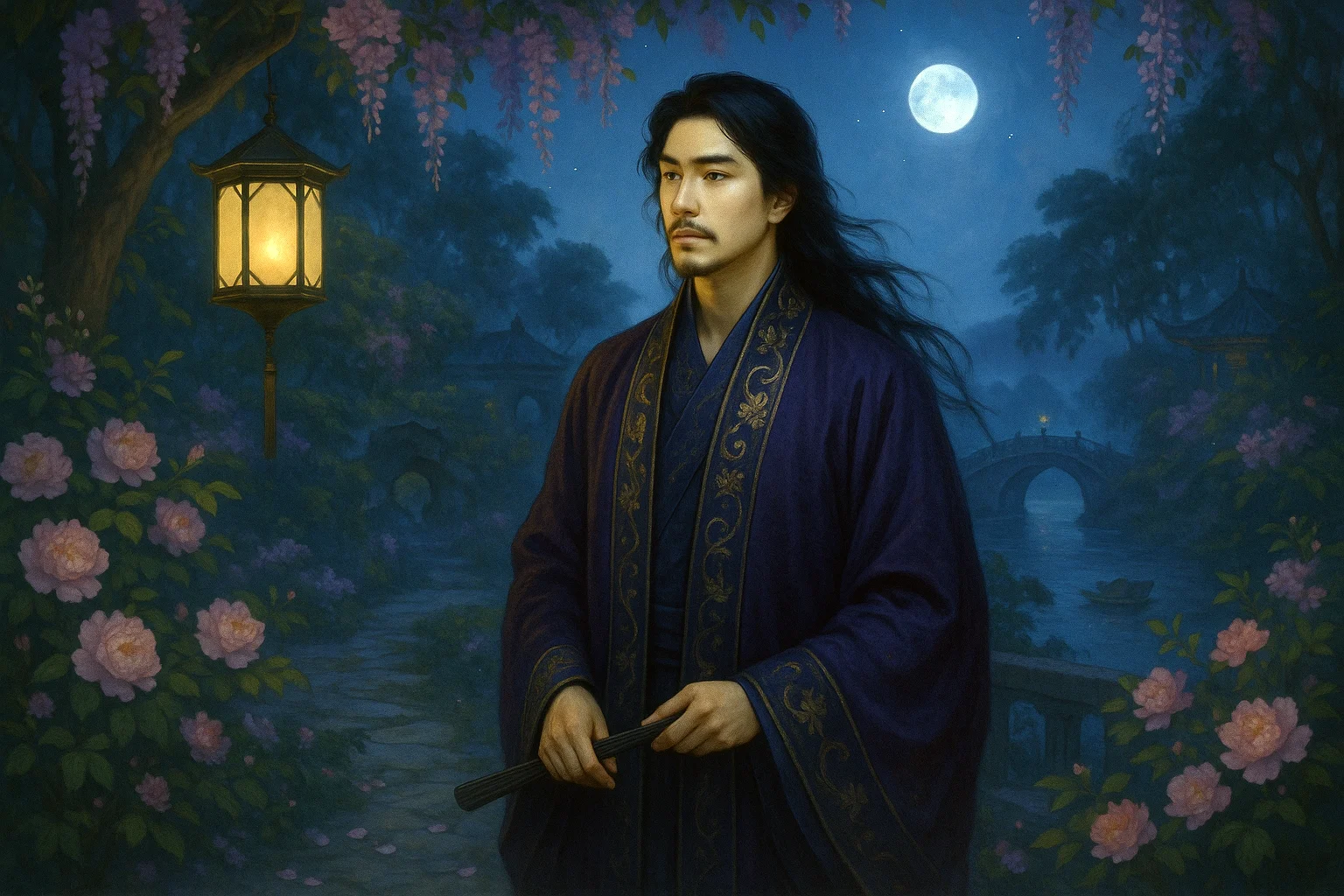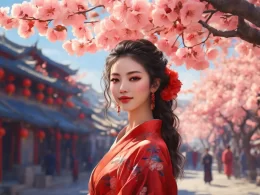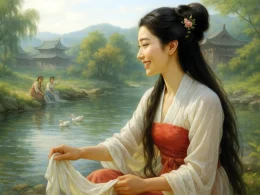I am lying in a white-lined coat while the spring approaches,
But am thinking only of the White Gate City where I cannot be.
...There are two red chambers fronting the cold, hidden by the rain,
And a lantern on a pearl screen swaying my lone heart homeward.
...The long road ahead will be full of new hardship,
With, late in the nights, brief intervals of dream.
Oh, to send you this message, this pair of jade earrings! --
I watch a lonely wildgoose in three thousand miles of cloud.
Original Poem
「春雨」
李商隐
怅卧新春白袷衣, 白门寥落意多违。
红楼隔雨相望冷, 珠箔飘灯独自归。
远路应悲春晼晚, 残宵犹得梦依稀。
玉珰缄札何由达, 万里云罗一雁飞。
Interpretation
This poem by Li Shangyin expresses parting sorrow against the backdrop of spring rain. Through misty spring rain imagery - the solitary lamp in deep night, dreams of distant journeys - the poet conveys longing and helplessness for a beloved. This lyrical technique gives the poem strong emotional power, characteristic of Li Shangyin's subtle, restrained style. The symbolic imagery resonates deeply, revealing the poet's inner solitude and melancholy.
First Couplet: "怅卧新春白袷衣,白门寥落意多违。"
Chàng wò xīn chūn bái jiá yī, bái mén liáo luò yì duō wéi.
In spring's new season, clad in white, I lie full of sorrow; By White Gate's desolation, all intentions thwarted.
The poet establishes season and mood. "Melancholy reclining" expresses inner anguish, while "White Gate" (originally Nanjing) symbolizes the separation site, implying lovesick depression.
Second Couplet: "红楼隔雨相望冷,珠箔飘灯独自归。"
Hóng lóu gé yǔ xiāng wàng lěng, zhū bó piāo dēng dú zì guī.
Through rain I gaze coldly at the crimson tower; Beaded curtains sway as I return alone by lamplight.
The poet visits his beloved's residence but finds the rain creates unbridgeable distance. The rainy scene with swaying curtains and floating lamplight creates bleak imagery mirroring his solitude.
Third Couplet: "远路应悲春晼晚,残宵犹得梦依稀。"
Yuǎn lù yīng bēi chūn wǎn wǎn, cán xiāo yóu dé mèng yī xī.
On distant roads you too mourn spring's twilight; In night's remains I grasp faint dream-meetings.
Shifting from reality to illusion, this suggests the distant beloved also grieves spring's passing, while the poet faintly meets her in dreams - intensifying parting sorrow through reality-dream interplay.
Fourth Couplet: "玉珰缄札何由达,万里云罗一雁飞。"
Yù dāng jiān zhá hé yóu dá, wàn lǐ yún luó yī yàn fēi.
How can my jade-adorned letters reach you? Through clouded skies flies one lone wild goose.
Returning to reality, the poet laments undeliverable letters, relying only on a solitary goose as messenger - symbolizing unattainable longing that deepens the poem's lonely atmosphere.
Overall Appreciation
This poem expresses lovesickness through circuitous, subtle language, using spring rain to reflect parting sorrow with lingering pathos. The opening establishes season and mood - early spring's lingering chill finds the poet in white garments, melancholy and reclining, depressed by separation. The second couplet depicts lovesick solitude: braving rain to gaze at his beloved's residence, so near yet so far, increasing helplessness. Night falls, beaded curtains flutter in wind and rain, lamplight illuminating his lonely figure returning disappointed. The third couplet shifts from reality to dreams - their faint meeting makes waking more painful. The finale returns to reality's frustration: letters undeliverable, overcast skies with one lone goose symbolizing longing. Alternating near-far perspectives and reality-dream fusion create expansive yet delicate artistry. Images like "spring rain," "crimson tower," "beaded curtains," "distant roads," "clouded skies" and "lone goose" create misty melancholy, symbolically expressing longing to make abstract emotions more poignant.
Progressing from melancholy reclining, to helpless gazing, to dream meetings, then undelivered letters, the poem's layered emotions are profoundly moving. Elegant, restrained language with harmonious rhythm displays Li Shangyin's distinctive subtle lyricism.
Writing Characteristics
- Rich symbolic imagery: "Spring rain," "crimson tower," "beaded curtains," "night's remains," "morning stars," "distant roads," "clouded skies" and "lone goose" create misty melancholy for restrained yet far-reaching emotional expression.
- Reality-dream interplay: Free movement between real-world helplessness and dream-world fleeting joy creates poignant contrasts that deepen parting sorrow.
- Layered emotional progression: From melancholy reclining to helpless gazing to dream meetings to undelivered letters - this step-by-step intensification creates lingering pathos.
- Elegant diction with melodious rhythm: The refined, restrained language flows harmoniously, enhancing artistic charm through musicality.
Insights
Using spring rain to express parting sorrow, this poem delicately portrays lovesickness while acknowledging the helplessness of human separation across time and space. It reminds us that while distance may cause temporary parting, true affection isn't diminished by external factors. The poet's symbolic technique makes longing tangible, showing how environmental and dream imagery can deepen emotional expression. The "undelivered letters/wild goose messenger" imagery also reveals ancient restrained yet profound emotional expression - worth treasuring in our fast-paced modern world that often neglects human connections. The poem ultimately teaches us to cherish present relationships while pursuing our dreams.
Poem translator
Kiang Kanghu
About the poet

Li Shangyin (李商隐), 813 - 858 AD, was a great poet of the late Tang Dynasty. His poems were on a par with those of Du Mu, and he was known as "Little Li Du". Li Shangyin was a native of Qinyang, Jiaozuo City, Henan Province. When he was a teenager, he lost his father at the age of nine, and was called "Zheshui East and West, half a century of wandering".











